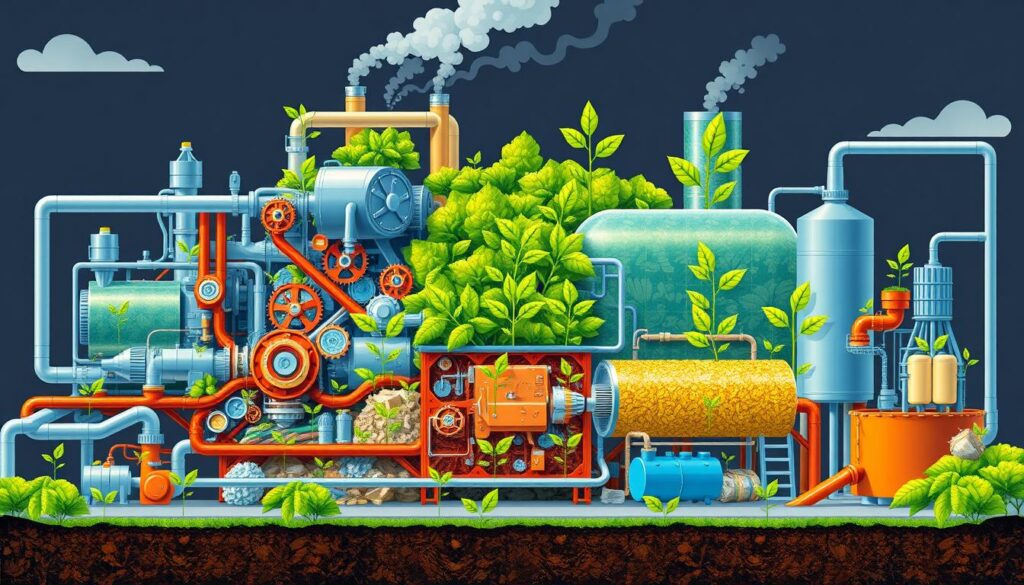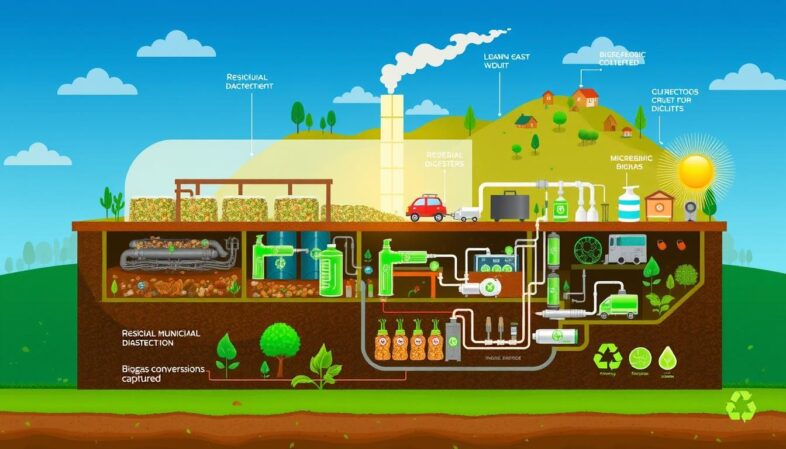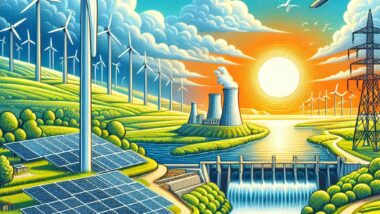Dry anaerobic digestion is a new way to manage waste with the benefit of renewable energy extraction from residual municipal waste and other wastes with a high organic content. It uses tiny organisms in the digestate that is recirculated as an inoculum into fresh waste batches to turn waste into biogas, a clean energy source. This method helps reduce waste sent to landfills, and reduces the pollution potential of any resulting landfilled waste and creates energy.
The European Union aims to be carbon neutral by 2050. Bioenergy, which will in future make up 70% of the EU's renewable energy, is key to this goal. By 2030, the EU wants at least 32% of its energy to come from renewable sources. Dry anaerobic digestion of waste can be a big part of this plan.
This method is great for waste with a lot of solid content. It's perfect for the organic part of municipal waste, which is as much as 30% of all residual waste in the EU. As of 2023, collecting this waste separately has been required, making this technology even more important.
Key Takeaways
- Dry anaerobic digestion converts residual waste into renewable energy
- It supports EU's 2050 carbon neutrality goal
- The process is ideal for high solid content (low moisture) municipal waste
- OFMSW (the Organic Fraction of Municipal Solid Waste) constitutes up to 42.3% of EU's total municipal solid waste
- Mandatory OFMSW collection started at the end of 2023
- The technology reduces landfill use and generates clean energy
Understanding Dry Anaerobic Digestion Technology
Dry anaerobic digestion technology is changing how we manage waste and make renewable energy. It turns organic waste into biogas. This is a green way to handle municipal waste.
Definition and Basic Principles
Solid-state anaerobic digestion, or dry anaerobic digestion, breaks down organic matter without oxygen. It works with biomass that's 20-55% dry matter. This method uses batch mode in sealed chambers, needing less water.
Comparison with Wet Anaerobic Digestion
Dry anaerobic digestion is better for big operations than wet digestion. It can handle more impurities and needs less human help. Here are the main differences:
| Feature | Dry Anaerobic Digestion | Wet Anaerobic Digestion |
|---|---|---|
| Total Solids Content | 20-55% | 10-15% |
| Water Requirement | Low | High |
| Operational Workload | Less manual intervention | Continuous (24/7) |
| Tolerance to Impurities | High | Low |
But there is a downside, and that is that dry anaerobic digestion produces less biogas than wet AD.
Key Components and System Design
A dry anaerobic digestion system has 3 key parts. These comprise the digester, biogas collection, and digestate handling. The design focuses on the waste and the process to boost efficiency. The system is flexible, with loading and unloading of each batch every 18-21 days.
Benefits of Municipal Waste Treatment Through Dry AD
Dry anaerobic digestion (AD) is a top choice for treating municipal waste. It fits well with green waste management. This method is great at turning waste into energy, helping communities cut down on landfill use.
Dry AD is good at handling many types of organic waste. It can deal with waste that has a lot of solid content. This makes it perfect for mixed household waste.

The environmental benefits of dry AD are big. It stops organic waste from going to landfills, cutting down methane emissions. Dry AD can also reduce volatile solids in waste by up to 50%.
Another plus is the biogas it produces. This gas is mostly methane and carbon dioxide. It can be used for heating and electricity, helping in a circular economy.
| Benefit | Impact |
|---|---|
| Landfill Diversion | Reduces waste volume and methane emissions |
| Renewable Energy | Produces biogas for heat and electricity |
| Digestate Production | Creates valuable fertiliser for agriculture |
| Resource Recovery | Supports circular economy principles when the waste is first recycled in a materials recycling facility (often known as a MRF) |
Dry AD also makes a by-product known as digestate, a nutrient-rich product. If there is very low toxicity in the digestate it can be used as fertiliser or soil conditioner. This not only brings in extra money but also helps in sustainable farming but is most often not possible due to contaminants in the waste processed.
In summary, dry anaerobic digestion is a strong option for managing municipal waste. It offers many benefits for the environment, economy, and resource recovery. It generally meets the goals of modern sustainable waste management.
Process Flow and Operating Parameters
The dry anaerobic digestion system is a cost-effective way to process organic waste. It maximises biogas production and manages digestate efficiently. Let's look at the main stages of this process.
Feedstock Reception and Preparation
Organic waste is sorted to remove contaminants when it arrives. It's then shredded and mixed to get the right carbon-to-nitrogen ratio. This ratio is between 20:1 and 30:1. It helps in efficient digestion and boosts biomethane generation.
Thermophilic Digestion Process
The system works in the thermophilic range (122-140°F), speeding up decomposition. This temperature range means shorter retention times than mesophilic systems. But, it needs careful monitoring because it's sensitive to feedstock changes.
Biogas Collection and Processing
Biogas, with 50-60% methane and 40-50% carbon dioxide, is collected all the time. It's purified to remove hydrogen sulphide and ammonia. This makes high-quality biomethane for energy.
Digestate Management
The digestate is rich in nutrients and is great for soil. It has a lot of ammonium, which is good for slow-release fertiliser. This makes it valuable for farming.
| Parameter | Optimal Range | Monitoring Frequency |
|---|---|---|
| Temperature | 122-140°F | Twice daily |
| pH | 6.8-8.0 | Twice daily |
| Total Solids | 2-10% | Daily |
| FOS/TAC Ratio | Varies | Twice monthly |
Checking these parameters regularly helps keep biogas production high and the system stable. This boosts the efficiency of the dry anaerobic digestion process.
Mechanical and Biological Treatment Integration

The MBT waste process mixes mechanical sorting and biological treatment. This method boosts resource recovery from mixed waste. It also manages solid waste well, cutting down landfill use and emissions.
Mechanical sorting in MBT systems sorts waste into recyclables, RDF, and organic materials. New tech like magnetic separation and optical sensors help increase recycling. RDF, with 8-20 MJ/kg energy, can replace fossil fuels in industry.
The biological part of MBT includes anaerobic digestion or composting. Anaerobic digestion makes biogas, a mix of 50-70% methane and 30-50% carbon dioxide. This green energy can power things up to 43% efficiently, reaching 90% in heat and power combos.
| MBT Component | Function | Output |
|---|---|---|
| Mechanical Sorting | Separates waste | Recyclables, RDF, Organics |
| Anaerobic Digestion | Breaks down organics | Biogas, Digestate |
| Composting | Stabilises organics | Compost-like output |
MBT systems, though pricey at first, help meet green goals. They lessen waste and methane emissions. They also make poor soil for land use and help avoid landfilling biodegradable waste, supporting a circular economy.
Biogas Production and Energy Generation
Biogas from waste is key in turning waste into energy. It's a green way to handle organic waste and make clean power.
Biogas Composition and Quality
Biogas is mostly methane (CH4), 50-75%. The rest is carbon dioxide (CO2) and a bit of hydrogen sulfide (H2S). The quality of biogas changes based on what it's made from and how it's digested.
Energy Conversion Technologies
There are many ways to use biogas's energy:
- Combined Heat and Power (CHP) systems make electricity and heat
- Biogas upgrading makes biomethane for the grid or cars
- Fuel cells turn biogas into electricity very efficiently
Power Generation Efficiency
The efficiency of turning biogas into energy depends on the tech used. CHP systems are usually 80-90% efficient. They make about 35% electricity and 50% heat.
| Technology | Electrical Efficiency | Overall Efficiency |
|---|---|---|
| CHP Systems | 35-40% | 80-90% |
| Fuel Cells | 40-60% | 85-90% |
| Microturbines | 25-30% | 75-85% |
Biogas plants can make a lot of energy. For example, a plant handling 20,000 tonnes of biowaste a year can power about 1,200 homes with electricity from two CHP units.
Substrate Requirements and Characteristics
The success of dry anaerobic digestion (SSAD) depends on the right organic waste. Knowing what makes good substrates is key for making biogas well and keeping systems running smoothly.
Optimal Feedstock Composition
Dry anaerobic digestion systems work best with 20-40% dry matter. This includes food waste and agricultural residues. For example, a facility in Palo Alto uses food waste, yard trimmings, and commercial food waste.

Carbon-to-Nitrogen Ratio Management
Getting the carbon-to-nitrogen (C:N) ratio right is crucial. It should be between 20:1 to 30:1. Mixing nitrogen-rich food waste with carbon-rich yard trimmings can improve digestion by 30-50%.
Moisture Content Considerations
SSAD can handle more solid content than wet systems. This means less water is needed and less energy for mixing. It's more efficient for certain organic waste types.
| Parameter | Dry Anaerobic Digestion | Wet Anaerobic Digestion |
|---|---|---|
| Dry Matter Content | 20-40% | 10-20% |
| Water Requirement | Low | High |
| Energy for Mixing | Lower | Higher |
| Suitable Waste Types | Food waste, Yard trimmings | Liquid manure, Sewage sludge |
By managing these substrate characteristics well, SSAD systems can efficiently handle a variety of organic waste. This helps with sustainable waste management and renewable energy.
Environmental Impact and Sustainability
Dry anaerobic digestion is key for managing waste and making renewable energy. It tackles food waste, which makes up 30% of municipal waste. By not sending organic waste to landfills, it cuts down on harmful emissions.
This method has big environmental wins. Food waste in landfills adds up to 8% of global carbon emissions. Advanced anaerobic digestion turns this waste into useful resources, lessening its harm.
The biogas from dry anaerobic digestion is a clean energy source. It can power homes, businesses, and vehicles. This reduces our need for fossil fuels and gives us clean energy.
Another plus is the nutrient-rich digestate it produces. This can enrich soil and act as a fertiliser, supporting a circular economy in farming. It also makes organic matter stable, cutting down on bad smells in waste management.
Dry anaerobic digestion is part of a bigger push for handling organic waste better. It aims to get the most value from waste, saving costs and making energy. As more places and businesses invest, we move closer to a greener future.
| Environmental Benefit | Impact |
|---|---|
| Greenhouse Gas Reduction | Significant decrease compared to traditional waste management |
| Renewable Energy Production | Biogas for heat, electricity, and vehicle fuel |
| Soil Improvement | Nutrient-rich digestate as fertiliser |
| Odour Reduction | Stabilisation of organic matter reduces nuisance |
Despite challenges like high costs and policy needs, dry anaerobic digestion's benefits are clear. As tech improves and awareness grows, it will become more vital for managing waste and making renewable energy.
Economic Viability and Market Analysis
Dry anaerobic digestion is becoming a key method for turning waste into energy. It's driven by the need for sustainable waste management and renewable energy. This technology is great for making biomethane and cutting down on greenhouse gases.
Capital and Operating Costs
Starting a dry anaerobic digestion plant can cost a lot, but it's worth it in the long run. It's cheaper to run than old waste management ways. This is because it can handle dry organic waste easily.
Revenue Streams and ROI
Dry anaerobic digestion plants can make money in several ways:
- Selling electricity and heat from biogas
- Creating fuel for vehicles
- Marketing digestate as fertiliser
- Charging for waste processing
Investing in this technology can pay off well, thanks to government help and renewable energy credits. For example, a plant handling 90,000 tons of waste a year can produce about 1.6MW of clean energy.
Market Growth Potential
The market for dry anaerobic digestion is set to grow a lot. This growth is due to:
- Tighter waste management rules
- More people living in cities and producing waste
- More money going into renewable energy
- New tech making systems more efficient
As the world focuses more on being green, the need for efficient waste-to-energy tech like dry anaerobic digestion will grow. This opens up big chances for the market to expand.
| Parameter | Value |
|---|---|
| Annual Energy Resource (U.S. wet waste feedstocks) | 42.9 billion litres gasoline equivalent |
| Biogas Methane Content | 40-75% |
| Biogas Carbon Dioxide Content | 15-60% |
| Potential Power Generation (90,000 tons/year facility) | 1.6MW |
Case Studies and Success Stories
Dry anaerobic digestion is becoming more popular worldwide. Many successful projects show its potential. Let's look at some examples in Europe and North America.
European Implementations
Europe is at the forefront of using dry digestion technology. There are 244 active anaerobic digestion facilities across the continent. These plants process 5% of Europe's organic waste, showing the technology's potential.
The Kompogas system is a leading dry anaerobic digester in Europe. Its success comes from supportive policies and high prices for renewable energy.
North American Projects
In the United States, there are over 1,500 anaerobic digestion projects. But only 61 are stand-alone systems for municipal solid waste. Dry digestion technology is becoming more popular, though.
GreenWaste's Renewable Energy Digestion Facility in San Jose, California, is a great example. It uses dryqube dry anaerobic digester technology. It's the largest commercial dry fermentation AD plant in the US. It produces clean energy and creates compost.
In Wisconsin, there's a big chance for dry digestion. The state has 323 dairy farms that could use this technology. It could cut methane emissions by 85% on 358 farms.
| Location | Number of AD Facilities | Processing Capacity |
|---|---|---|
| Europe | 244 | 5% of organic material |
| United States | 61 (stand-alone MSW) | Varies by facility |
| Wisconsin | 43 (operational) | Potential for 358 farms |
These examples show how dry digestion technology is being used more in waste management and renewable energy.
Conclusion
Dry anaerobic digestion (DAD) is a key solution for managing waste and making renewable energy. It tackles the problem of municipal waste while creating useful biogas. This method is great for handling agricultural waste and animal manure because it can handle high-solid content.
DAD's success is clear from its performance. Studies show that the right mix of carbon and nitrogen can produce up to 2.5 L·d⁻¹ of biogas. It also uses less water, making it perfect for areas where water is scarce.
The future looks bright for dry anaerobic digestion in waste management. With so much agricultural waste and manure around, DAD offers a big chance for recycling and energy. By using this technology, we can move closer to a circular economy. This means turning waste into something valuable and helping our planet.
FAQ
What is dry anaerobic digestion?
How does dry anaerobic digestion differ from wet anaerobic digestion?
What are the main benefits of dry anaerobic digestion?
What types of waste can be processed through dry anaerobic digestion?
How is biogas produced in dry anaerobic digestion used?
What is the optimal temperature range for dry anaerobic digestion?
How does dry anaerobic digestion contribute to the circular economy?
What is the carbon-to-nitrogen ratio in dry anaerobic digestion, and why is it important?
How does dry anaerobic digestion integrate with Mechanical and Biological Treatment (MBT) systems?
What are some successful examples of dry anaerobic digestion implementations?
- Dry Anaerobic Digestion of the Organic Fraction of Municipal Solid Waste: Biogas Production Optimization by Reducing Ammonia Inhibition
- GreenWaste Renewable Energy Digestion Facility – GreenWaste
- Comparison of Biogas Technologies
- A Review on Dry Anaerobic Digestion: Existing Technologies, Performance Factors, Challenges, and Recommendations
- Evaluating Anaerobic Digestion for Municipal Organics Recycling
- How Anaerobic Digestion Processes Treat Municipal Solid Waste
- A Review of the Processes, Parameters, and Optimization of Anaerobic Digestion
- Analysis of Process Parameters for Anaerobic Digestion and RNG Plants
- Mechanical biological treatment – Anaerobic Digestion
- MBT Waste – Mechanical Biological Treatment of Waste
- Fact Sheet | Biogas: Converting Waste to Energy | White Papers
- Production of Biogas from Food Waste | Shapiro
- Anaerobic Digestion explained
- State-of-the-art Dry and Wet Anaerobic Digestion Systems for Solid Waste :BiogasWorld
- Anaerobic Digestion of Lignocellulosic Biomass: Substrate Characteristics (Challenge) and Innovation
- Anaerobic Digestion: A Solution to the Food Waste Crisis
- Environmental Benefits of Anaerobic Digestion
- Anaerobic digestate management, environmental impacts, and techno-economic challenges
- Dry Anaerobic Digestion Market Size, Share, Growth, Trends, Statistics Analysis Report and By Segment Forecasts 2024 to 2033
- Economic Perspectives of Biogas Production via Anaerobic Digestion
- Successful Applications of Anaerobic Digestion from Across the World
- Findyourhomein thecity
- Evaluation of the efficiency of dry anaerobic digester in the production of biogas and fertilizer using activated sludge and plant waste – Scientific Reports
- Dry Anaerobic Digestion for Agricultural Waste Recycling




